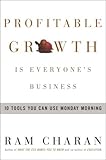Product Description
The coauthor of the international bestseller Execution has created the how-to guide for solving today’s toughest business challenge: creating profitable growth that is organic, differentiated, and sustainable.
For many, growth is about “home runs”—the big bold idea, the next new thing, the product that will revolutionize the marketplace. While obviously attractive and lucrative, home runs don’t happen every day and frequently come in cycles. … More >>
Profitable Growth Is Everyone’s Business: 9 Tools You Can Use Monday Morning



Charan co-authored Execution: The Discipline of Getting Things Done with Larry Bossidy and has written numerous articles in which he examines various causes and effects of what I view as organizational dysfunction. In this volume, he correctly insists that responsibility for profitable growth must be shared by everyone involved. He offers “Ten Tools” by which to achieve that important objective. First, he identifies three barriers to such growth: “First, the balance has gone too far in the direction of cost-cutting at the expense of revenue growth…Second, when most managers think about growth, it is in terms of home runs — the disruptive technology, the new revolutionary business model, the mega-merger — instead of the singles and doubles that, when executed at a steady pace, cumulatively can increase revenue substantially…Third, improving productivity and increasing revenues are seen as two separate issues, when they are, in fact, inseparable for long-term success. If managers concentrate only on raising productivity, they are only doing half their job.” To these I presume to add a fourth barrier which Jim O’Toole discusses in Leading Change: “the ideology of comfort and the tyranny of custom.” Charan obviously has this barrier in mind when correctly insisting that several mind-sets which endure as received wisdom are, in fact, dead wrong.
With regard to the “Ten Tools” which Charan recommends, no surprises there. My concern, frankly, is that some readers will cherry-pick a few, try them, and then “see what happens.” That would be serious mistake. Rather, they should see all ten as separate but interdependent core principles to guide and inform the design and implementation of a cohesive, comprehensive, and cost-effective system by which to achieve and then sustain profitable growth. At a time when so many business books are published which offer answers, I especially appreciate Charan’s inclusion of several lists of questions which are relevant to or evoked by a specific issue or problem. For example, in the Conclusion (pages 196-198), he poses a series of questions which will help a reader to determine whether or not she or he is now part of a growth business. My own opinion is that these are precisely the same questions which decision-makers in any organization (regardless of size or nature) should frequently ask. Why not dedicate a half-day, select a group of (let’s say 10-12 key people), distribute these questions in advance among them, and then meet in executive session to share responses? Then reach consensus on specific action steps to be taken…by whom…with each being assigned a deadline.
Those who share my high regard for this book are urged to check out Jim Collins’ Good to Great, Michael Hammer’s The Agenda, Paul Niven’s Balanced Scorecard Step by Step, and Chris Zook’s Beyond the Core.
Rating: 5 / 5
I had heard great things about Ram Charan, so perhaps my expectations were set a bit high. I realy got very little out of this, indeed, I didn’t finish it. This review is of the audio edition. I have a bias against professional readers who don’t understand what they are reading. While the reading was very professional, it tended to put one to sleep, because the reader didn’t know where the important infections were. Other details like pronouncing DEC (Digital Equipment) as “Dee Eee Cee” added to the impression.
Rating: 2 / 5
This excellent, short work is a classic in its genre. Author Ram Charan outlines in no-nonsense, albeit sometimes prolix, style the essentials that all managers need to know to make their businesses and their revenues grow. Charan offers 10 basic principles, explains each one clearly, and provides anecdotal examples. The author readily admits that the principles are mostly common sense, and even perhaps widely understood (in part, from his other popular works). However, he says that the problem for most businesses is not having the right ideas, but rather turning the ideas into action. We recommend this mainstay for any business manager’s bookshelf. It will help you face the challenge of growth.
Rating: 5 / 5
This study of “growth” is important reading for all managers. Too often, growth is considered the Holy Grail of management, resulting in more, more, more without thought of the potentials for “better” growth that is possible or the dangers of “bad growth”. This book is short, incisive and well worth your time.
Rating: 4 / 5
Bought the book for a planning event for the company and most enjoy reading it. Really easy to read but packed with great insights and valuable lessons.
Rating: 5 / 5